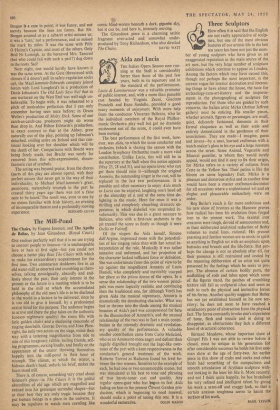Three Sculptors
How often it is said that the English are not really appreciative of sculp- ture, but one of the most obvious features of our artistic life in the last ten years has been not just the num- ber of young sculptors who have given us an exaggerated reputation as the main source of the art now, but the very large number of sculpture exhibitions which continue to appear in London. Among the factors which may have caused this, though not perhaps the most important, is the current vogue for interior decoration and interest- ing things to have about the house, the taste for archmology-cum-art-history and the improve- ments in the photographing of sculpture for reproduction. For those who are guided by such concerns, the Italian artist Mirko (Arthur Jeffress gallery) must be enticing. His smaller pieces, whether animals, figures or personages, are small, quiet, delicately fashioned, domestic in their formal eloquence as well as their scale and entirely domesticated in the gentleness of their associations. They are made—I imagine, guess and invent—by a neat, learned craftsman with a watch-maker's glass in his eye and a large museum across the street. Some Animal, Vegetable and Mineral panellist, to whom they would surely appeal, would not find it easy to fix their origin, for Mirko refers to a variety of cultures from Crete to the Yellow Sea. Their patina is like the bloom on some legendary fruit. Mirko is a. pleasant and dexterous stylist and in another time would have been a master craftsman-decorator for all occasions where a sophisticated wit and an elegiac and pleasurable melancholy were on order.
Reg Butler's reach is far more ambitious and his new show of bronzes at the Hanover proves how radical has been his evolution from forged iron to the present work. The skeletal iron creatures were tough, devoid of sensuousness and, in their deliberated analytical reduction of fleshy volumes to metal lines, rational. His present yearning and feetless women are as erotic. in spirit as anything in English art with an emphasis upon buttocks and breasts and the life-force. But per- haps the change is not so absolute after all, for their presence is still restrained and cooled by the reasoning deliberation of an artist not quite possessed by the feelings which he seeks to pro- ject. The absence of certain bodily parts, the scaffolding of rods and tubes upon which some of the figures stand, the patches of crumbling texture still fail as sculptural ideas and seem as such to curb the physical and instinctive forces of his forms. Another quality suggests that Butler has not yet established himself in his new ter- ritory; he does not seem to have reached a satisfactory point of abstraction from the physical fact. The forms constantly invoke one's experience of bone, flesh and muscle and in doing so disappoint; as abstractions they lack a different kind of structural coherence.
Bernard Meadows, whose important show at Gimpel Fils I was not able to review before it closed, must be unique in his generation for after considerable successes he holds his first one- man show at the age of forty-two. An earlier piece in this show of crabs and cocks and other birds had something of the compactness and smooth articulation of Scythian sculpture with- out looking in the least bit like it. More recently, and not I think quite happily, he has brutalised his very refined and intelligent talent by giving his work a sawn-off and craggy look, so that a certain anxious toughness seems to haunt the surface of his work.
BASIL TAYLOR






























 Previous page
Previous page